Occupation Health and Safety
VerifiedAdded on 2023/05/31
|9
|2721
|486
AI Summary
This paper proposes a wellness plan to address the issue of excessive smoking among Amazon employees in Canada. The plan includes a smoking cessation program to promote positive health and wellness among employees. The paper discusses the needs analysis, content, training design and delivery, and evaluation of the program.
Contribute Materials
Your contribution can guide someone’s learning journey. Share your
documents today.
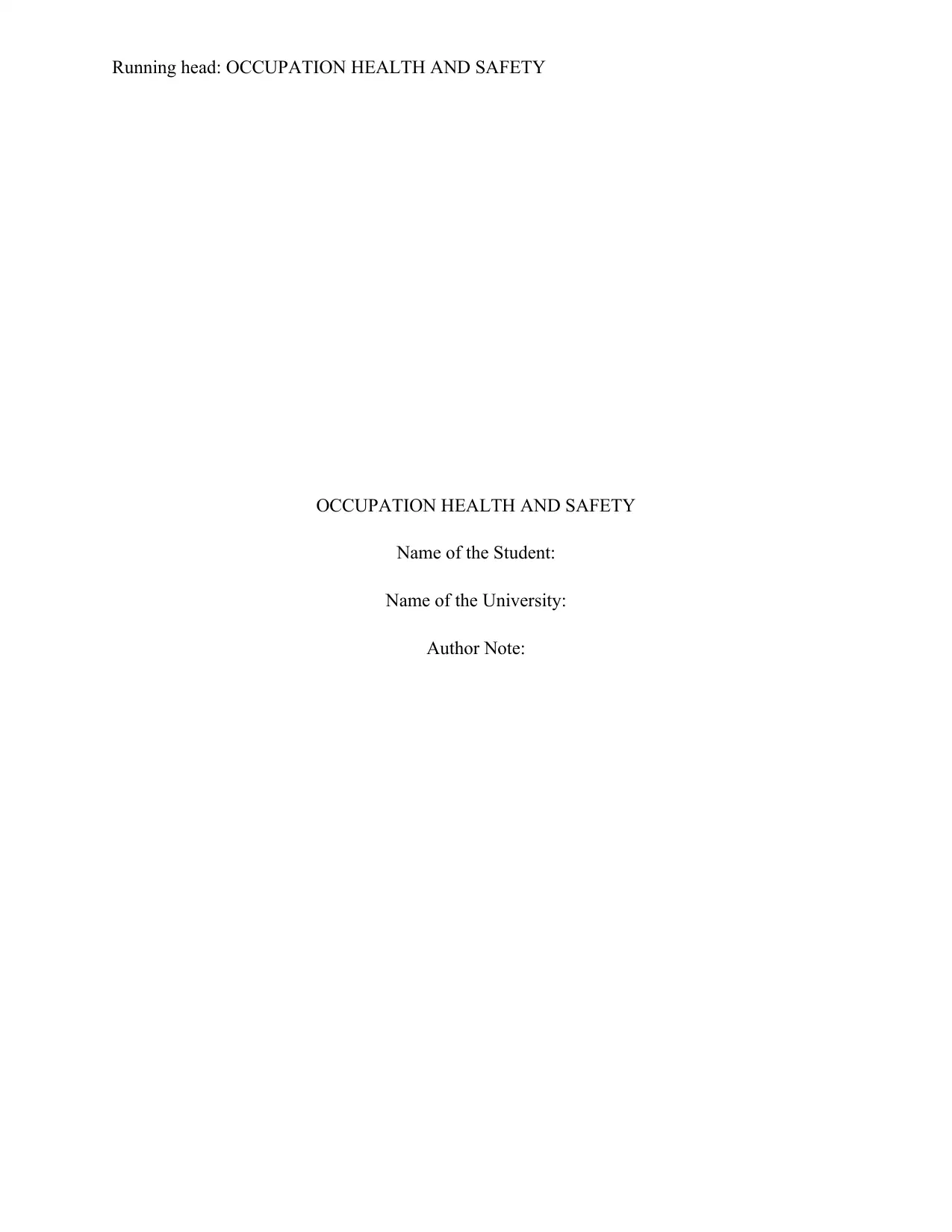
Running head: OCCUPATION HEALTH AND SAFETY
OCCUPATION HEALTH AND SAFETY
Name of the Student:
Name of the University:
Author Note:
OCCUPATION HEALTH AND SAFETY
Name of the Student:
Name of the University:
Author Note:
Secure Best Marks with AI Grader
Need help grading? Try our AI Grader for instant feedback on your assignments.
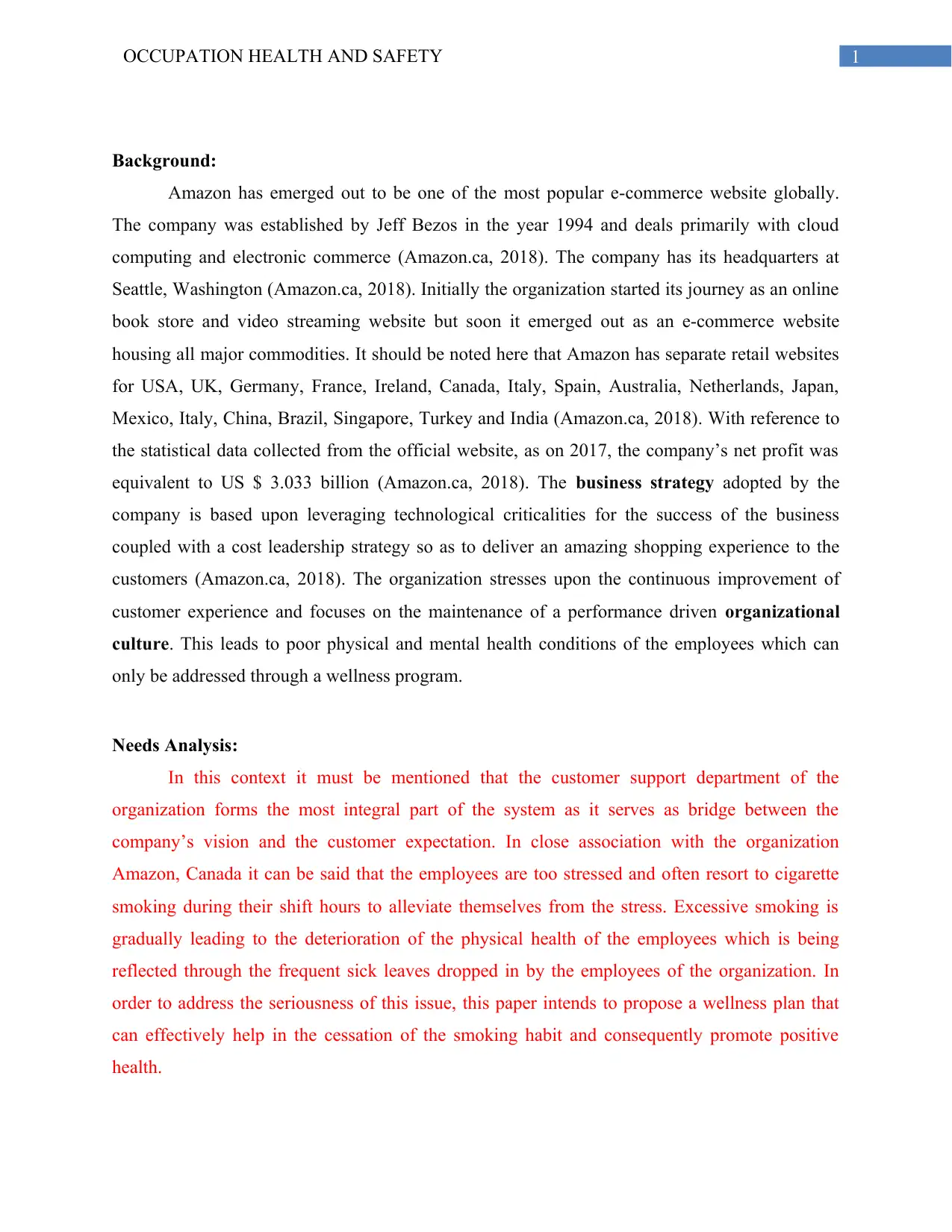
1OCCUPATION HEALTH AND SAFETY
Background:
Amazon has emerged out to be one of the most popular e-commerce website globally.
The company was established by Jeff Bezos in the year 1994 and deals primarily with cloud
computing and electronic commerce (Amazon.ca, 2018). The company has its headquarters at
Seattle, Washington (Amazon.ca, 2018). Initially the organization started its journey as an online
book store and video streaming website but soon it emerged out as an e-commerce website
housing all major commodities. It should be noted here that Amazon has separate retail websites
for USA, UK, Germany, France, Ireland, Canada, Italy, Spain, Australia, Netherlands, Japan,
Mexico, Italy, China, Brazil, Singapore, Turkey and India (Amazon.ca, 2018). With reference to
the statistical data collected from the official website, as on 2017, the company’s net profit was
equivalent to US $ 3.033 billion (Amazon.ca, 2018). The business strategy adopted by the
company is based upon leveraging technological criticalities for the success of the business
coupled with a cost leadership strategy so as to deliver an amazing shopping experience to the
customers (Amazon.ca, 2018). The organization stresses upon the continuous improvement of
customer experience and focuses on the maintenance of a performance driven organizational
culture. This leads to poor physical and mental health conditions of the employees which can
only be addressed through a wellness program.
Needs Analysis:
In this context it must be mentioned that the customer support department of the
organization forms the most integral part of the system as it serves as bridge between the
company’s vision and the customer expectation. In close association with the organization
Amazon, Canada it can be said that the employees are too stressed and often resort to cigarette
smoking during their shift hours to alleviate themselves from the stress. Excessive smoking is
gradually leading to the deterioration of the physical health of the employees which is being
reflected through the frequent sick leaves dropped in by the employees of the organization. In
order to address the seriousness of this issue, this paper intends to propose a wellness plan that
can effectively help in the cessation of the smoking habit and consequently promote positive
health.
Background:
Amazon has emerged out to be one of the most popular e-commerce website globally.
The company was established by Jeff Bezos in the year 1994 and deals primarily with cloud
computing and electronic commerce (Amazon.ca, 2018). The company has its headquarters at
Seattle, Washington (Amazon.ca, 2018). Initially the organization started its journey as an online
book store and video streaming website but soon it emerged out as an e-commerce website
housing all major commodities. It should be noted here that Amazon has separate retail websites
for USA, UK, Germany, France, Ireland, Canada, Italy, Spain, Australia, Netherlands, Japan,
Mexico, Italy, China, Brazil, Singapore, Turkey and India (Amazon.ca, 2018). With reference to
the statistical data collected from the official website, as on 2017, the company’s net profit was
equivalent to US $ 3.033 billion (Amazon.ca, 2018). The business strategy adopted by the
company is based upon leveraging technological criticalities for the success of the business
coupled with a cost leadership strategy so as to deliver an amazing shopping experience to the
customers (Amazon.ca, 2018). The organization stresses upon the continuous improvement of
customer experience and focuses on the maintenance of a performance driven organizational
culture. This leads to poor physical and mental health conditions of the employees which can
only be addressed through a wellness program.
Needs Analysis:
In this context it must be mentioned that the customer support department of the
organization forms the most integral part of the system as it serves as bridge between the
company’s vision and the customer expectation. In close association with the organization
Amazon, Canada it can be said that the employees are too stressed and often resort to cigarette
smoking during their shift hours to alleviate themselves from the stress. Excessive smoking is
gradually leading to the deterioration of the physical health of the employees which is being
reflected through the frequent sick leaves dropped in by the employees of the organization. In
order to address the seriousness of this issue, this paper intends to propose a wellness plan that
can effectively help in the cessation of the smoking habit and consequently promote positive
health.
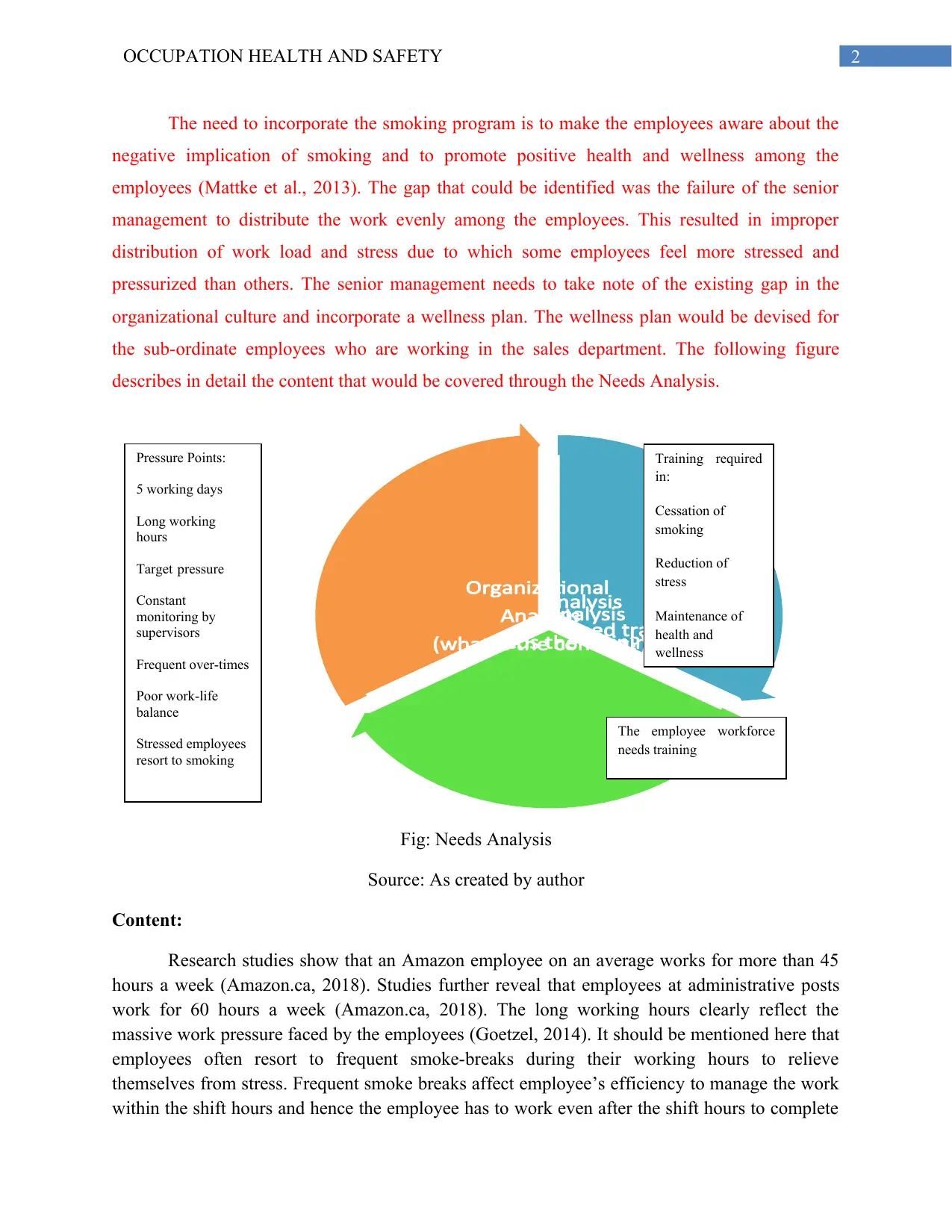
2OCCUPATION HEALTH AND SAFETY
The need to incorporate the smoking program is to make the employees aware about the
negative implication of smoking and to promote positive health and wellness among the
employees (Mattke et al., 2013). The gap that could be identified was the failure of the senior
management to distribute the work evenly among the employees. This resulted in improper
distribution of work load and stress due to which some employees feel more stressed and
pressurized than others. The senior management needs to take note of the existing gap in the
organizational culture and incorporate a wellness plan. The wellness plan would be devised for
the sub-ordinate employees who are working in the sales department. The following figure
describes in detail the content that would be covered through the Needs Analysis.
Fig: Needs Analysis
Source: As created by author
Content:
Research studies show that an Amazon employee on an average works for more than 45
hours a week (Amazon.ca, 2018). Studies further reveal that employees at administrative posts
work for 60 hours a week (Amazon.ca, 2018). The long working hours clearly reflect the
massive work pressure faced by the employees (Goetzel, 2014). It should be mentioned here that
employees often resort to frequent smoke-breaks during their working hours to relieve
themselves from stress. Frequent smoke breaks affect employee’s efficiency to manage the work
within the shift hours and hence the employee has to work even after the shift hours to complete
Task Analysis
In what do they need training?
Person Analysis
Who needs the training?
Organizational
Analysis
(what is the context?)
Pressure Points:
5 working days
Long working
hours
Target pressure
Constant
monitoring by
supervisors
Frequent over-times
Poor work-life
balance
Stressed employees
resort to smoking
Training required
in:
Cessation of
smoking
Reduction of
stress
Maintenance of
health and
wellness
The employee workforce
needs training
The need to incorporate the smoking program is to make the employees aware about the
negative implication of smoking and to promote positive health and wellness among the
employees (Mattke et al., 2013). The gap that could be identified was the failure of the senior
management to distribute the work evenly among the employees. This resulted in improper
distribution of work load and stress due to which some employees feel more stressed and
pressurized than others. The senior management needs to take note of the existing gap in the
organizational culture and incorporate a wellness plan. The wellness plan would be devised for
the sub-ordinate employees who are working in the sales department. The following figure
describes in detail the content that would be covered through the Needs Analysis.
Fig: Needs Analysis
Source: As created by author
Content:
Research studies show that an Amazon employee on an average works for more than 45
hours a week (Amazon.ca, 2018). Studies further reveal that employees at administrative posts
work for 60 hours a week (Amazon.ca, 2018). The long working hours clearly reflect the
massive work pressure faced by the employees (Goetzel, 2014). It should be mentioned here that
employees often resort to frequent smoke-breaks during their working hours to relieve
themselves from stress. Frequent smoke breaks affect employee’s efficiency to manage the work
within the shift hours and hence the employee has to work even after the shift hours to complete
Task Analysis
In what do they need training?
Person Analysis
Who needs the training?
Organizational
Analysis
(what is the context?)
Pressure Points:
5 working days
Long working
hours
Target pressure
Constant
monitoring by
supervisors
Frequent over-times
Poor work-life
balance
Stressed employees
resort to smoking
Training required
in:
Cessation of
smoking
Reduction of
stress
Maintenance of
health and
wellness
The employee workforce
needs training
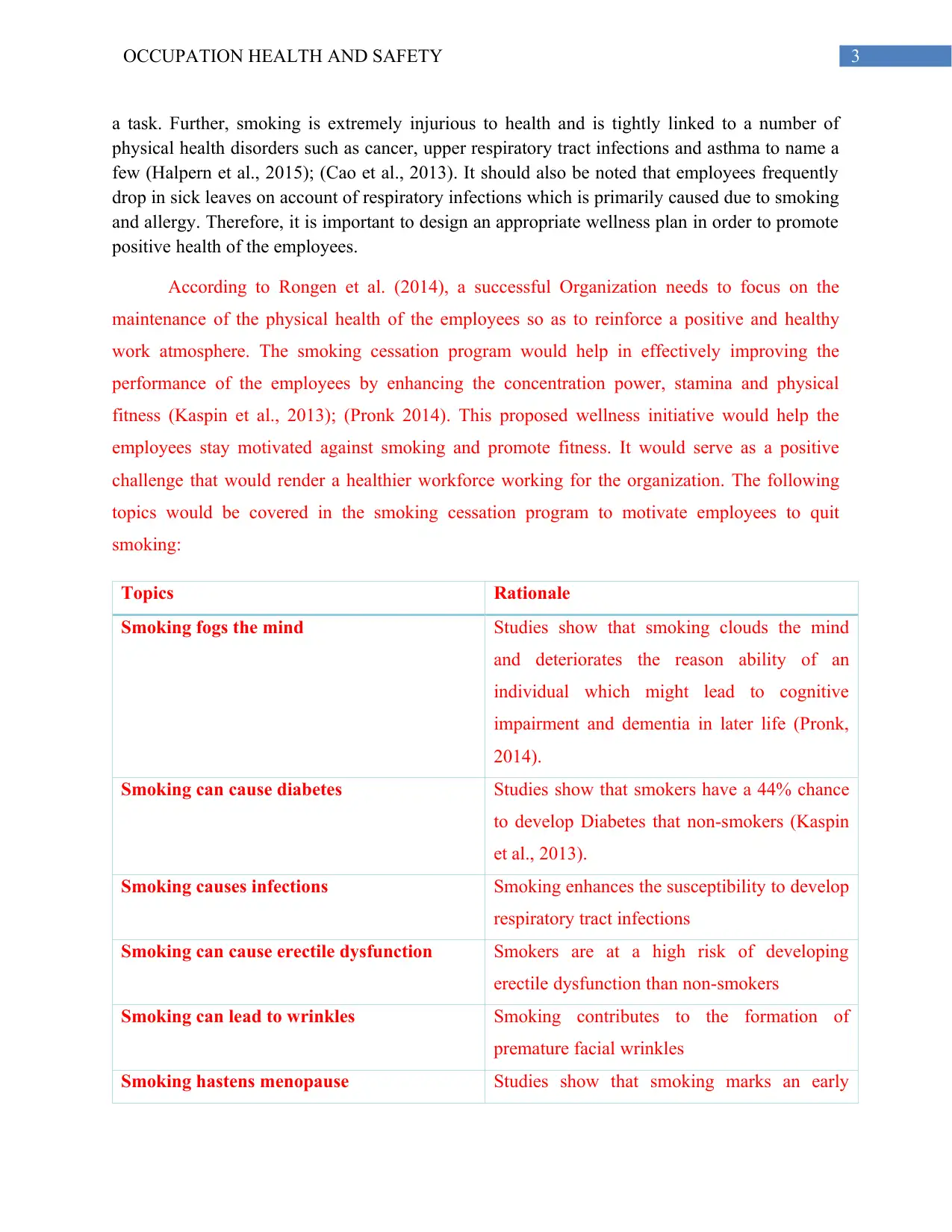
3OCCUPATION HEALTH AND SAFETY
a task. Further, smoking is extremely injurious to health and is tightly linked to a number of
physical health disorders such as cancer, upper respiratory tract infections and asthma to name a
few (Halpern et al., 2015); (Cao et al., 2013). It should also be noted that employees frequently
drop in sick leaves on account of respiratory infections which is primarily caused due to smoking
and allergy. Therefore, it is important to design an appropriate wellness plan in order to promote
positive health of the employees.
According to Rongen et al. (2014), a successful Organization needs to focus on the
maintenance of the physical health of the employees so as to reinforce a positive and healthy
work atmosphere. The smoking cessation program would help in effectively improving the
performance of the employees by enhancing the concentration power, stamina and physical
fitness (Kaspin et al., 2013); (Pronk 2014). This proposed wellness initiative would help the
employees stay motivated against smoking and promote fitness. It would serve as a positive
challenge that would render a healthier workforce working for the organization. The following
topics would be covered in the smoking cessation program to motivate employees to quit
smoking:
Topics Rationale
Smoking fogs the mind Studies show that smoking clouds the mind
and deteriorates the reason ability of an
individual which might lead to cognitive
impairment and dementia in later life (Pronk,
2014).
Smoking can cause diabetes Studies show that smokers have a 44% chance
to develop Diabetes that non-smokers (Kaspin
et al., 2013).
Smoking causes infections Smoking enhances the susceptibility to develop
respiratory tract infections
Smoking can cause erectile dysfunction Smokers are at a high risk of developing
erectile dysfunction than non-smokers
Smoking can lead to wrinkles Smoking contributes to the formation of
premature facial wrinkles
Smoking hastens menopause Studies show that smoking marks an early
a task. Further, smoking is extremely injurious to health and is tightly linked to a number of
physical health disorders such as cancer, upper respiratory tract infections and asthma to name a
few (Halpern et al., 2015); (Cao et al., 2013). It should also be noted that employees frequently
drop in sick leaves on account of respiratory infections which is primarily caused due to smoking
and allergy. Therefore, it is important to design an appropriate wellness plan in order to promote
positive health of the employees.
According to Rongen et al. (2014), a successful Organization needs to focus on the
maintenance of the physical health of the employees so as to reinforce a positive and healthy
work atmosphere. The smoking cessation program would help in effectively improving the
performance of the employees by enhancing the concentration power, stamina and physical
fitness (Kaspin et al., 2013); (Pronk 2014). This proposed wellness initiative would help the
employees stay motivated against smoking and promote fitness. It would serve as a positive
challenge that would render a healthier workforce working for the organization. The following
topics would be covered in the smoking cessation program to motivate employees to quit
smoking:
Topics Rationale
Smoking fogs the mind Studies show that smoking clouds the mind
and deteriorates the reason ability of an
individual which might lead to cognitive
impairment and dementia in later life (Pronk,
2014).
Smoking can cause diabetes Studies show that smokers have a 44% chance
to develop Diabetes that non-smokers (Kaspin
et al., 2013).
Smoking causes infections Smoking enhances the susceptibility to develop
respiratory tract infections
Smoking can cause erectile dysfunction Smokers are at a high risk of developing
erectile dysfunction than non-smokers
Smoking can lead to wrinkles Smoking contributes to the formation of
premature facial wrinkles
Smoking hastens menopause Studies show that smoking marks an early
Secure Best Marks with AI Grader
Need help grading? Try our AI Grader for instant feedback on your assignments.

4OCCUPATION HEALTH AND SAFETY
onset of menopause in women.
Smoking impairs vision Smokers are at a three times risk of developing
blurred vision
Smoking leads to osteoporosis Smoking has been invariably linked to cause
osteoporosis in both the sexes
Smoking impairs the digestive system Smoking harms the digestive system and
causes peptic ulcers and gallstones
Smoking can impair sleep pattern Nicotine disrupts the normal sleeping pattern in
smokers (Goetzel et al., 2014)
Smoking leads to cancer Smoking has been linked to a number of
cancers
Smoking shortens life Non-smokers have been reported to live longer
than smokers
The smoking cessation program would be stringently monitored for a time period of six
months. During the entire tenure the documentation would be thoroughly maintained that would
keep a track about the percentage of employee participation and the monthly progress. At the end
of the training program, the outcome would be measured on the basis of two evaluation
measures. The first would consider the amount of employee participation. Employee-
participation lower than 75% would reflect the failure in satisfying the first objective of the
program. The second would consider the percentage of tobacco free/healthy individuals after the
completion of the program. A percentage lower than at least 35% of tobacco-free individuals
would reflect the failure of the devised wellness program.
Training Design and Delivery:
The smoking cessation program would be based upon two defined objectives that would
require training at three phases. The three phases would include imparting training on-job, off-
job and reinforcing a technology-based training. The structure and planning of the training
program is discussed as under:
onset of menopause in women.
Smoking impairs vision Smokers are at a three times risk of developing
blurred vision
Smoking leads to osteoporosis Smoking has been invariably linked to cause
osteoporosis in both the sexes
Smoking impairs the digestive system Smoking harms the digestive system and
causes peptic ulcers and gallstones
Smoking can impair sleep pattern Nicotine disrupts the normal sleeping pattern in
smokers (Goetzel et al., 2014)
Smoking leads to cancer Smoking has been linked to a number of
cancers
Smoking shortens life Non-smokers have been reported to live longer
than smokers
The smoking cessation program would be stringently monitored for a time period of six
months. During the entire tenure the documentation would be thoroughly maintained that would
keep a track about the percentage of employee participation and the monthly progress. At the end
of the training program, the outcome would be measured on the basis of two evaluation
measures. The first would consider the amount of employee participation. Employee-
participation lower than 75% would reflect the failure in satisfying the first objective of the
program. The second would consider the percentage of tobacco free/healthy individuals after the
completion of the program. A percentage lower than at least 35% of tobacco-free individuals
would reflect the failure of the devised wellness program.
Training Design and Delivery:
The smoking cessation program would be based upon two defined objectives that would
require training at three phases. The three phases would include imparting training on-job, off-
job and reinforcing a technology-based training. The structure and planning of the training
program is discussed as under:
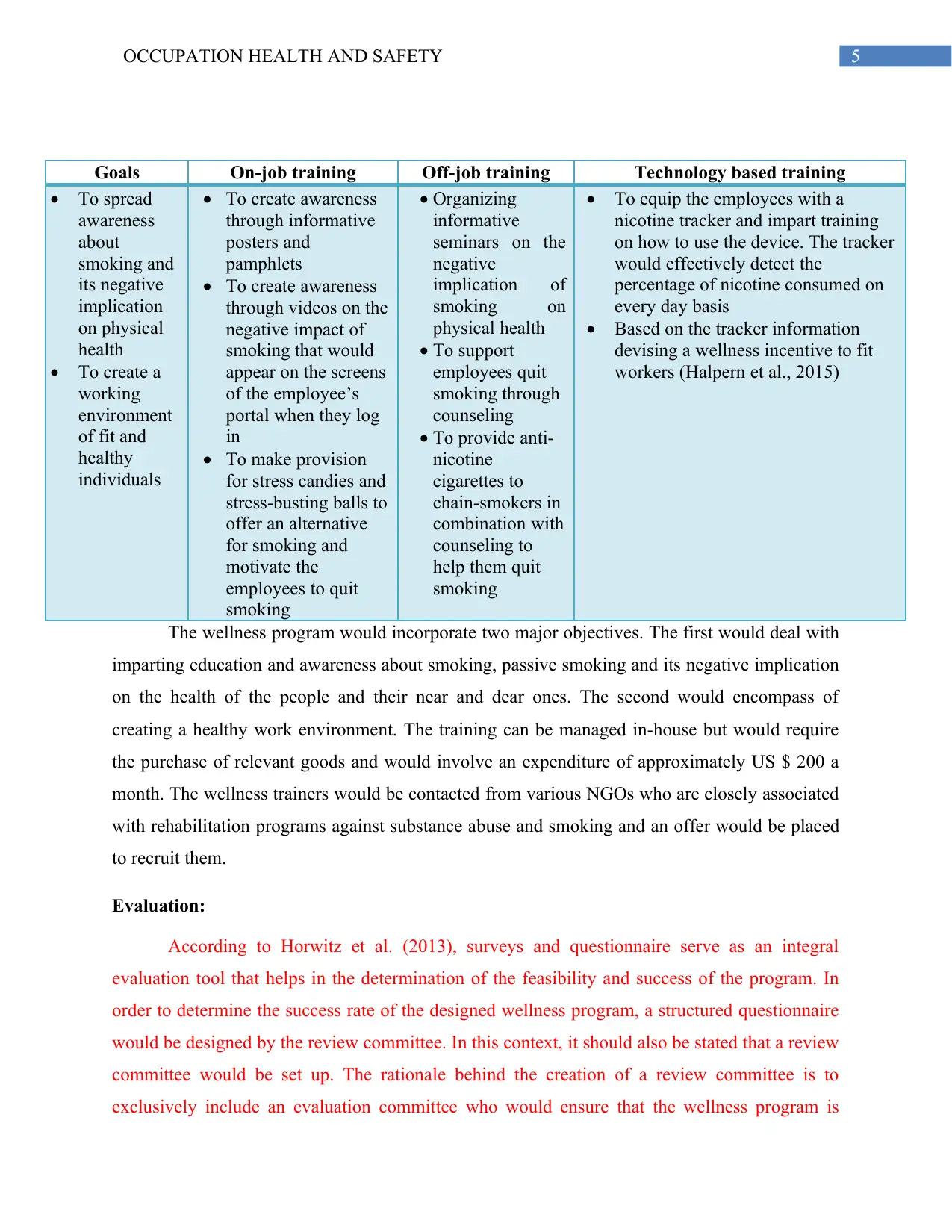
5OCCUPATION HEALTH AND SAFETY
Goals On-job training Off-job training Technology based training
To spread
awareness
about
smoking and
its negative
implication
on physical
health
To create a
working
environment
of fit and
healthy
individuals
To create awareness
through informative
posters and
pamphlets
To create awareness
through videos on the
negative impact of
smoking that would
appear on the screens
of the employee’s
portal when they log
in
To make provision
for stress candies and
stress-busting balls to
offer an alternative
for smoking and
motivate the
employees to quit
smoking
Organizing
informative
seminars on the
negative
implication of
smoking on
physical health
To support
employees quit
smoking through
counseling
To provide anti-
nicotine
cigarettes to
chain-smokers in
combination with
counseling to
help them quit
smoking
To equip the employees with a
nicotine tracker and impart training
on how to use the device. The tracker
would effectively detect the
percentage of nicotine consumed on
every day basis
Based on the tracker information
devising a wellness incentive to fit
workers (Halpern et al., 2015)
The wellness program would incorporate two major objectives. The first would deal with
imparting education and awareness about smoking, passive smoking and its negative implication
on the health of the people and their near and dear ones. The second would encompass of
creating a healthy work environment. The training can be managed in-house but would require
the purchase of relevant goods and would involve an expenditure of approximately US $ 200 a
month. The wellness trainers would be contacted from various NGOs who are closely associated
with rehabilitation programs against substance abuse and smoking and an offer would be placed
to recruit them.
Evaluation:
According to Horwitz et al. (2013), surveys and questionnaire serve as an integral
evaluation tool that helps in the determination of the feasibility and success of the program. In
order to determine the success rate of the designed wellness program, a structured questionnaire
would be designed by the review committee. In this context, it should also be stated that a review
committee would be set up. The rationale behind the creation of a review committee is to
exclusively include an evaluation committee who would ensure that the wellness program is
Goals On-job training Off-job training Technology based training
To spread
awareness
about
smoking and
its negative
implication
on physical
health
To create a
working
environment
of fit and
healthy
individuals
To create awareness
through informative
posters and
pamphlets
To create awareness
through videos on the
negative impact of
smoking that would
appear on the screens
of the employee’s
portal when they log
in
To make provision
for stress candies and
stress-busting balls to
offer an alternative
for smoking and
motivate the
employees to quit
smoking
Organizing
informative
seminars on the
negative
implication of
smoking on
physical health
To support
employees quit
smoking through
counseling
To provide anti-
nicotine
cigarettes to
chain-smokers in
combination with
counseling to
help them quit
smoking
To equip the employees with a
nicotine tracker and impart training
on how to use the device. The tracker
would effectively detect the
percentage of nicotine consumed on
every day basis
Based on the tracker information
devising a wellness incentive to fit
workers (Halpern et al., 2015)
The wellness program would incorporate two major objectives. The first would deal with
imparting education and awareness about smoking, passive smoking and its negative implication
on the health of the people and their near and dear ones. The second would encompass of
creating a healthy work environment. The training can be managed in-house but would require
the purchase of relevant goods and would involve an expenditure of approximately US $ 200 a
month. The wellness trainers would be contacted from various NGOs who are closely associated
with rehabilitation programs against substance abuse and smoking and an offer would be placed
to recruit them.
Evaluation:
According to Horwitz et al. (2013), surveys and questionnaire serve as an integral
evaluation tool that helps in the determination of the feasibility and success of the program. In
order to determine the success rate of the designed wellness program, a structured questionnaire
would be designed by the review committee. In this context, it should also be stated that a review
committee would be set up. The rationale behind the creation of a review committee is to
exclusively include an evaluation committee who would ensure that the wellness program is
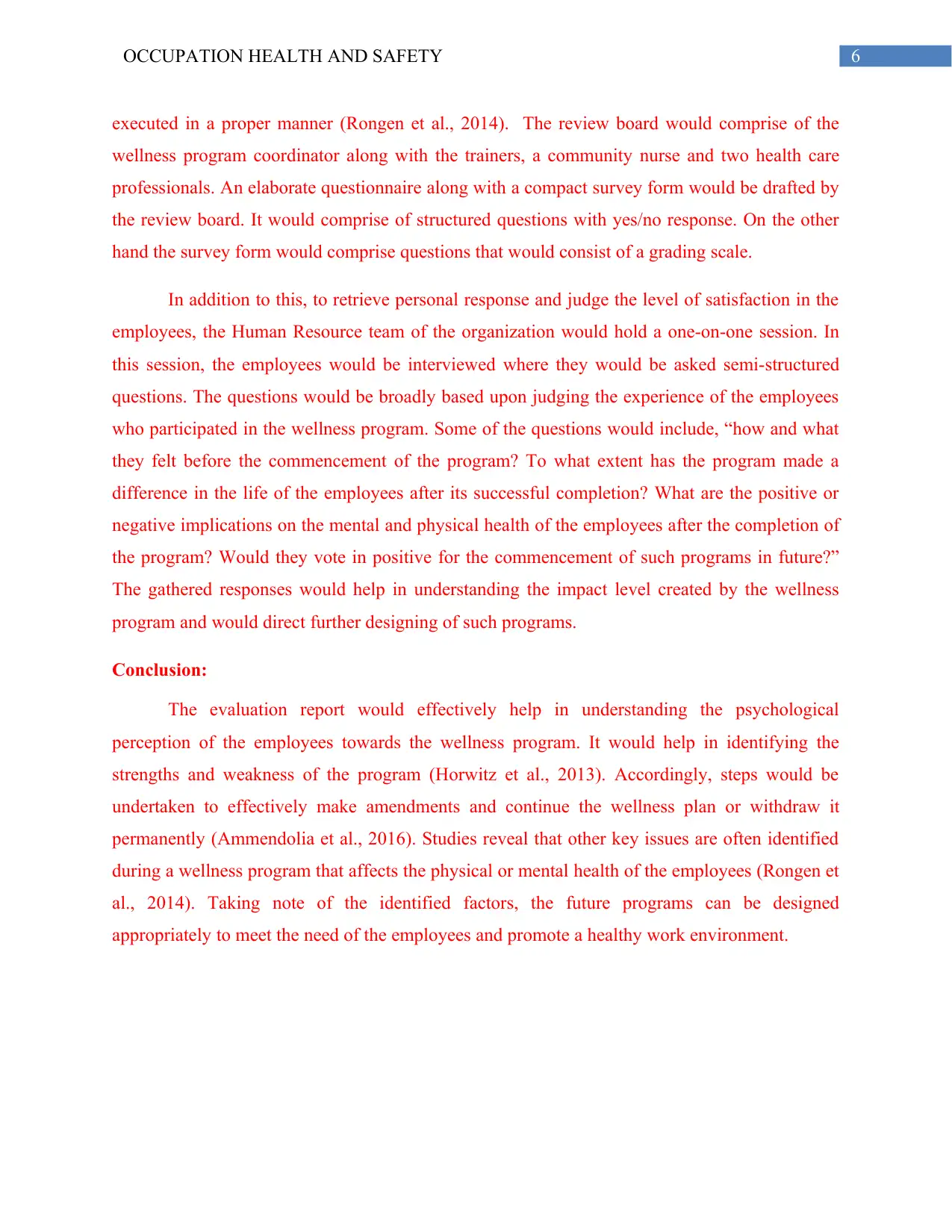
6OCCUPATION HEALTH AND SAFETY
executed in a proper manner (Rongen et al., 2014). The review board would comprise of the
wellness program coordinator along with the trainers, a community nurse and two health care
professionals. An elaborate questionnaire along with a compact survey form would be drafted by
the review board. It would comprise of structured questions with yes/no response. On the other
hand the survey form would comprise questions that would consist of a grading scale.
In addition to this, to retrieve personal response and judge the level of satisfaction in the
employees, the Human Resource team of the organization would hold a one-on-one session. In
this session, the employees would be interviewed where they would be asked semi-structured
questions. The questions would be broadly based upon judging the experience of the employees
who participated in the wellness program. Some of the questions would include, “how and what
they felt before the commencement of the program? To what extent has the program made a
difference in the life of the employees after its successful completion? What are the positive or
negative implications on the mental and physical health of the employees after the completion of
the program? Would they vote in positive for the commencement of such programs in future?”
The gathered responses would help in understanding the impact level created by the wellness
program and would direct further designing of such programs.
Conclusion:
The evaluation report would effectively help in understanding the psychological
perception of the employees towards the wellness program. It would help in identifying the
strengths and weakness of the program (Horwitz et al., 2013). Accordingly, steps would be
undertaken to effectively make amendments and continue the wellness plan or withdraw it
permanently (Ammendolia et al., 2016). Studies reveal that other key issues are often identified
during a wellness program that affects the physical or mental health of the employees (Rongen et
al., 2014). Taking note of the identified factors, the future programs can be designed
appropriately to meet the need of the employees and promote a healthy work environment.
executed in a proper manner (Rongen et al., 2014). The review board would comprise of the
wellness program coordinator along with the trainers, a community nurse and two health care
professionals. An elaborate questionnaire along with a compact survey form would be drafted by
the review board. It would comprise of structured questions with yes/no response. On the other
hand the survey form would comprise questions that would consist of a grading scale.
In addition to this, to retrieve personal response and judge the level of satisfaction in the
employees, the Human Resource team of the organization would hold a one-on-one session. In
this session, the employees would be interviewed where they would be asked semi-structured
questions. The questions would be broadly based upon judging the experience of the employees
who participated in the wellness program. Some of the questions would include, “how and what
they felt before the commencement of the program? To what extent has the program made a
difference in the life of the employees after its successful completion? What are the positive or
negative implications on the mental and physical health of the employees after the completion of
the program? Would they vote in positive for the commencement of such programs in future?”
The gathered responses would help in understanding the impact level created by the wellness
program and would direct further designing of such programs.
Conclusion:
The evaluation report would effectively help in understanding the psychological
perception of the employees towards the wellness program. It would help in identifying the
strengths and weakness of the program (Horwitz et al., 2013). Accordingly, steps would be
undertaken to effectively make amendments and continue the wellness plan or withdraw it
permanently (Ammendolia et al., 2016). Studies reveal that other key issues are often identified
during a wellness program that affects the physical or mental health of the employees (Rongen et
al., 2014). Taking note of the identified factors, the future programs can be designed
appropriately to meet the need of the employees and promote a healthy work environment.
Paraphrase This Document
Need a fresh take? Get an instant paraphrase of this document with our AI Paraphraser
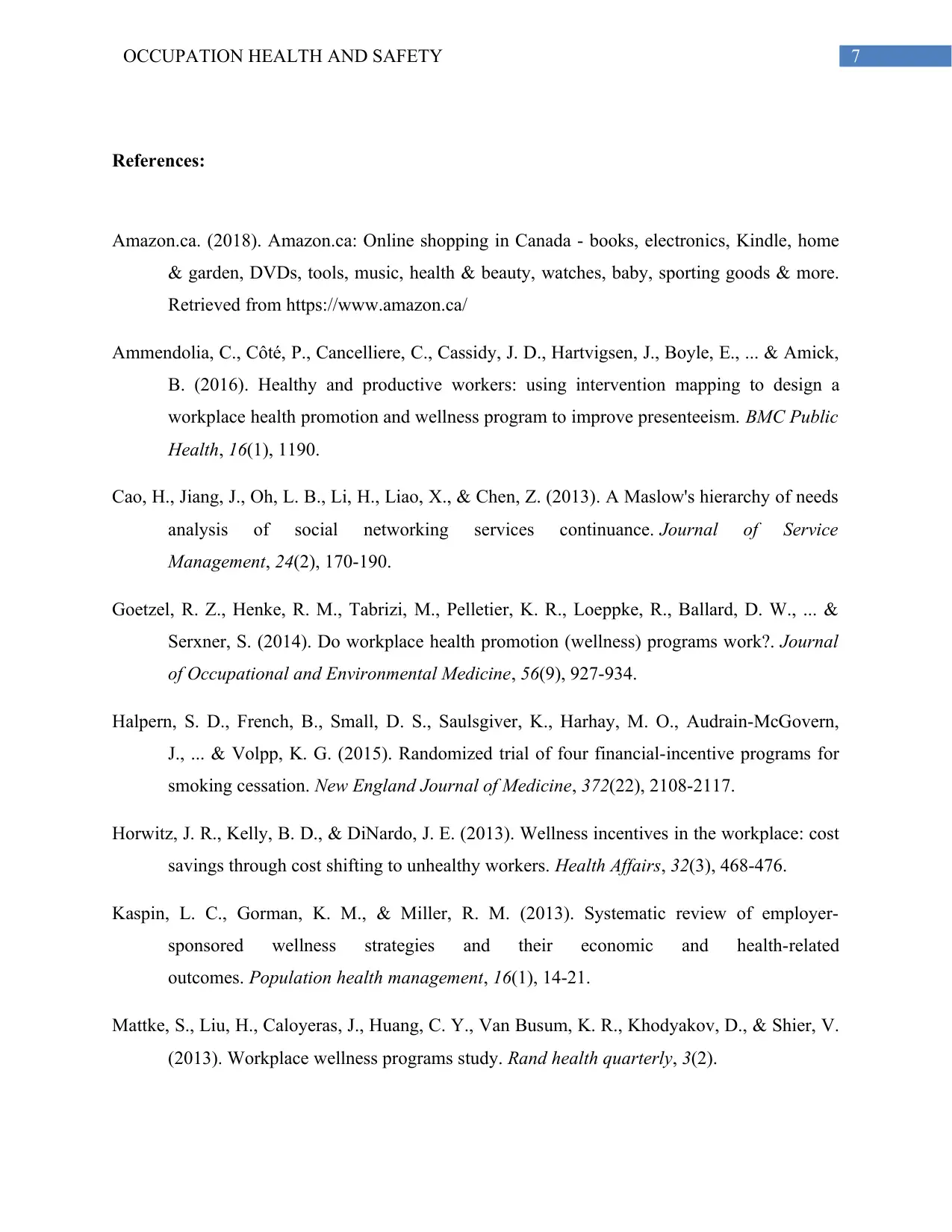
7OCCUPATION HEALTH AND SAFETY
References:
Amazon.ca. (2018). Amazon.ca: Online shopping in Canada - books, electronics, Kindle, home
& garden, DVDs, tools, music, health & beauty, watches, baby, sporting goods & more.
Retrieved from https://www.amazon.ca/
Ammendolia, C., Côté, P., Cancelliere, C., Cassidy, J. D., Hartvigsen, J., Boyle, E., ... & Amick,
B. (2016). Healthy and productive workers: using intervention mapping to design a
workplace health promotion and wellness program to improve presenteeism. BMC Public
Health, 16(1), 1190.
Cao, H., Jiang, J., Oh, L. B., Li, H., Liao, X., & Chen, Z. (2013). A Maslow's hierarchy of needs
analysis of social networking services continuance. Journal of Service
Management, 24(2), 170-190.
Goetzel, R. Z., Henke, R. M., Tabrizi, M., Pelletier, K. R., Loeppke, R., Ballard, D. W., ... &
Serxner, S. (2014). Do workplace health promotion (wellness) programs work?. Journal
of Occupational and Environmental Medicine, 56(9), 927-934.
Halpern, S. D., French, B., Small, D. S., Saulsgiver, K., Harhay, M. O., Audrain-McGovern,
J., ... & Volpp, K. G. (2015). Randomized trial of four financial-incentive programs for
smoking cessation. New England Journal of Medicine, 372(22), 2108-2117.
Horwitz, J. R., Kelly, B. D., & DiNardo, J. E. (2013). Wellness incentives in the workplace: cost
savings through cost shifting to unhealthy workers. Health Affairs, 32(3), 468-476.
Kaspin, L. C., Gorman, K. M., & Miller, R. M. (2013). Systematic review of employer-
sponsored wellness strategies and their economic and health-related
outcomes. Population health management, 16(1), 14-21.
Mattke, S., Liu, H., Caloyeras, J., Huang, C. Y., Van Busum, K. R., Khodyakov, D., & Shier, V.
(2013). Workplace wellness programs study. Rand health quarterly, 3(2).
References:
Amazon.ca. (2018). Amazon.ca: Online shopping in Canada - books, electronics, Kindle, home
& garden, DVDs, tools, music, health & beauty, watches, baby, sporting goods & more.
Retrieved from https://www.amazon.ca/
Ammendolia, C., Côté, P., Cancelliere, C., Cassidy, J. D., Hartvigsen, J., Boyle, E., ... & Amick,
B. (2016). Healthy and productive workers: using intervention mapping to design a
workplace health promotion and wellness program to improve presenteeism. BMC Public
Health, 16(1), 1190.
Cao, H., Jiang, J., Oh, L. B., Li, H., Liao, X., & Chen, Z. (2013). A Maslow's hierarchy of needs
analysis of social networking services continuance. Journal of Service
Management, 24(2), 170-190.
Goetzel, R. Z., Henke, R. M., Tabrizi, M., Pelletier, K. R., Loeppke, R., Ballard, D. W., ... &
Serxner, S. (2014). Do workplace health promotion (wellness) programs work?. Journal
of Occupational and Environmental Medicine, 56(9), 927-934.
Halpern, S. D., French, B., Small, D. S., Saulsgiver, K., Harhay, M. O., Audrain-McGovern,
J., ... & Volpp, K. G. (2015). Randomized trial of four financial-incentive programs for
smoking cessation. New England Journal of Medicine, 372(22), 2108-2117.
Horwitz, J. R., Kelly, B. D., & DiNardo, J. E. (2013). Wellness incentives in the workplace: cost
savings through cost shifting to unhealthy workers. Health Affairs, 32(3), 468-476.
Kaspin, L. C., Gorman, K. M., & Miller, R. M. (2013). Systematic review of employer-
sponsored wellness strategies and their economic and health-related
outcomes. Population health management, 16(1), 14-21.
Mattke, S., Liu, H., Caloyeras, J., Huang, C. Y., Van Busum, K. R., Khodyakov, D., & Shier, V.
(2013). Workplace wellness programs study. Rand health quarterly, 3(2).

8OCCUPATION HEALTH AND SAFETY
Pronk, N. (2014). Best practice design principles of worksite health and wellness
programs. ACSM's Health & Fitness Journal, 18(1), 42-46.
Rongen, A., Robroek, S. J., Van Ginkel, W., Lindeboom, D., Altink, B., & Burdorf, A. (2014).
Barriers and facilitators for participation in health promotion programs among
employees: a six-month follow-up study. BMC Public Health, 14(1), 573.
Pronk, N. (2014). Best practice design principles of worksite health and wellness
programs. ACSM's Health & Fitness Journal, 18(1), 42-46.
Rongen, A., Robroek, S. J., Van Ginkel, W., Lindeboom, D., Altink, B., & Burdorf, A. (2014).
Barriers and facilitators for participation in health promotion programs among
employees: a six-month follow-up study. BMC Public Health, 14(1), 573.
1 out of 9
Related Documents
Your All-in-One AI-Powered Toolkit for Academic Success.
+13062052269
info@desklib.com
Available 24*7 on WhatsApp / Email
![[object Object]](/_next/static/media/star-bottom.7253800d.svg)
Unlock your academic potential
© 2024 | Zucol Services PVT LTD | All rights reserved.





